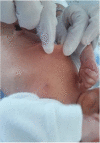Neonatal presentation of Loeys-Dietz syndrome: two case reports and review of the literature
- PMID: 35668506
- PMCID: PMC9169291
- DOI: 10.1186/s13052-022-01281-y
Neonatal presentation of Loeys-Dietz syndrome: two case reports and review of the literature
Abstract
Background: Loeys-Dietz syndrome (LDS) is a rare connective tissue disorder characterized by cardiovascular manifestations, especially aortic dilatations and arterial tortuosity, craniofacial and skeletal features, joint laxity or contractures, skin abnormalities, hypotonia and motor delay. Its diagnosis is established by the identification of a pathogenic variant in TGFBR1, TGFBR2, SMAD2, SMAD3, TGFB2 or TGFB3 genes. In newborns and toddlers, vascular complications such as aneurism rupture, aortic dissection, and intracerebral incidents, can occur already in the weeks of life. To avoid these events, it is crucial to precociously identify this condition and to start an apunderwent a surgical procedurepropriate treatment which, depending on the severity of the vascular involvement, might be medical or surgical.
Case presentation: We report two cases of Loeys-Dietz syndrome precociously diagnosed. The first describes a male, born at 38 + 1 weeks of gestation, with hypotonia, joint hypermobility, arachnodactyly, and fingers joint contractures, as well as senile appearance and facial dysmorphisms. In the suspect of a connective tissue disorder, an echocardiography was performed and revealed an aortic root dilatation of 13 mm (Z score + 3). A trio based Whole Exome Sequencing found a novel de novo variant in the TGFBR2 gene. Despite the onset of a low-dose angiotensin receptor blocker therapy, the aneurysm progressed. The second case describes a female, born at 41 + 3 weeks of gestation. During the neonatal examination a cleft palate was noticed, as well as minor dysmorphisms. Since the family history was suspicious for connective tissue disorders, a genetic panel was performed and identified a pathogenetic variant in TGFB3 gene. In this case, the echocardiography revealed no abnormalities.
Conclusions: In addition to our cases, we identified 14 subjects with neonatal LDS in the medical literature. All of them had aortic involvement. Skeletal and face abnormalities, including eyes and palate malformations, were also highly frequent. Overall, 10 subjects required medical therapy to avoid aneurysm progression, and 8 patients underwent surgical procedures. Benefits of an early diagnosis of LDS are various and imply a potential modification of the natural history of the disease with early interventions on its complications.
Keywords: Aneurysm; Connective tissue disorder; Loeys-Dietz syndrome; Newborn.
© 2022. The Author(s).
Conflict of interest statement
Francesco Baldo declares that he has no conflict of interest. Laura Morra declares that she has no conflict of interest. Agnese Feresin declares that she has no conflict of interest. Flavio Faletra declares that he has no conflict of interest. Yasmin Al Naber declares that she has no conflict of interest. Luigi Memo declares that he has no conflict of interest. Laura Travan declares that she has no conflict of interest.
Figures
Similar articles
-
Clinical diagnosis of Larsen syndrome, Stickler syndrome and Loeys-Dietz syndrome in a 19-year old male: a case report.BMC Med Genet. 2018 Aug 31;19(1):155. doi: 10.1186/s12881-018-0671-0. BMC Med Genet. 2018. PMID: 30170566 Free PMC article.
-
The first reported case of Loeys-Dietz syndrome in a patient with biallelic SMAD3 variants.Am J Med Genet A. 2020 Nov;182(11):2755-2760. doi: 10.1002/ajmg.a.61844. Epub 2020 Sep 15. Am J Med Genet A. 2020. PMID: 32935439
-
Genotypic Categorization of Loeys-Dietz Syndrome Based on 24 Novel Families and Literature Data.Genes (Basel). 2019 Sep 28;10(10):764. doi: 10.3390/genes10100764. Genes (Basel). 2019. PMID: 31569402 Free PMC article. Review.
-
Ectopia lentis in Loeys-Dietz syndrome type 4.Am J Med Genet A. 2020 Aug;182(8):1957-1959. doi: 10.1002/ajmg.a.61633. Epub 2020 May 28. Am J Med Genet A. 2020. PMID: 32462795
-
Arthrogryposis as neonatal presentation of Loeys-Dietz syndrome due to a novel TGFBR2 mutation.Eur J Med Genet. 2017 Jun;60(6):303-307. doi: 10.1016/j.ejmg.2017.03.010. Epub 2017 Mar 24. Eur J Med Genet. 2017. PMID: 28344185 Review.
Cited by
-
Advances for pediatricians in 2022: allergy, anesthesiology, cardiology, dermatology, endocrinology, gastroenterology, genetics, global health, infectious diseases, metabolism, neonatology, neurology, oncology, pulmonology.Ital J Pediatr. 2023 Sep 8;49(1):115. doi: 10.1186/s13052-023-01522-8. Ital J Pediatr. 2023. PMID: 37679850 Free PMC article. Review.
-
Perinatal genetic diagnostic yield in a population of fetuses with the phenotype arthrogryposis multiplex congenita: a cohort study 2007-2021.Eur J Hum Genet. 2025 Apr 7. doi: 10.1038/s41431-025-01848-3. Online ahead of print. Eur J Hum Genet. 2025. PMID: 40195522
-
A novel TGFBR2 mutation causes Loeys-Dietz syndrome in a Chinese infant: A case report.Heliyon. 2025 Jan 18;11(2):e42116. doi: 10.1016/j.heliyon.2025.e42116. eCollection 2025 Jan 30. Heliyon. 2025. PMID: 39906804 Free PMC article.
-
Identification of TGFBR1 Gene Variants in Two Chinese Pedigrees with Loeys-Dietz Syndrome.Braz J Cardiovasc Surg. 2025 Feb 12;40(1):e20230495. doi: 10.21470/1678-9741-2023-0495. Braz J Cardiovasc Surg. 2025. PMID: 39937695 Free PMC article.
-
Cleft Palate and Aortic Dilatation as Clues for Loeys-Dietz Syndrome.Children (Basel). 2022 Aug 26;9(9):1290. doi: 10.3390/children9091290. Children (Basel). 2022. PMID: 36138598 Free PMC article.
References
-
- Loeys BL, Chen J, Neptune ER, Judge DP, Podowski M, Holm T, Meyers J, Leitch CC, Katsanis N, Sharifi N, Xu FL, Myers LA, Spevak PJ, Cameron DE, De Backer J, Hellemans J, Chen Y, Davis EC, Webb CL, Kress W, Coucke P, Rifkin DB, De Paepe AM, Dietz HC. A syndrome of altered cardiovascular, craniofacial, neurocognitive and skeletal development caused by mutations in TGFBR1 or TGFBR2. Nat Genet. 2005;37(3):275–281. doi: 10.1038/ng1511. - DOI - PubMed
-
- Loeys BL, Dietz HC. Loeys-Dietz Syndrome. 2008 Feb 28 [Updated 2018 Mar 1]. In: Adam MP, Ardinger HH, Pagon RA, et al., editors. GeneReviews®.
Publication types
MeSH terms
Substances
LinkOut - more resources
Full Text Sources
Medical





